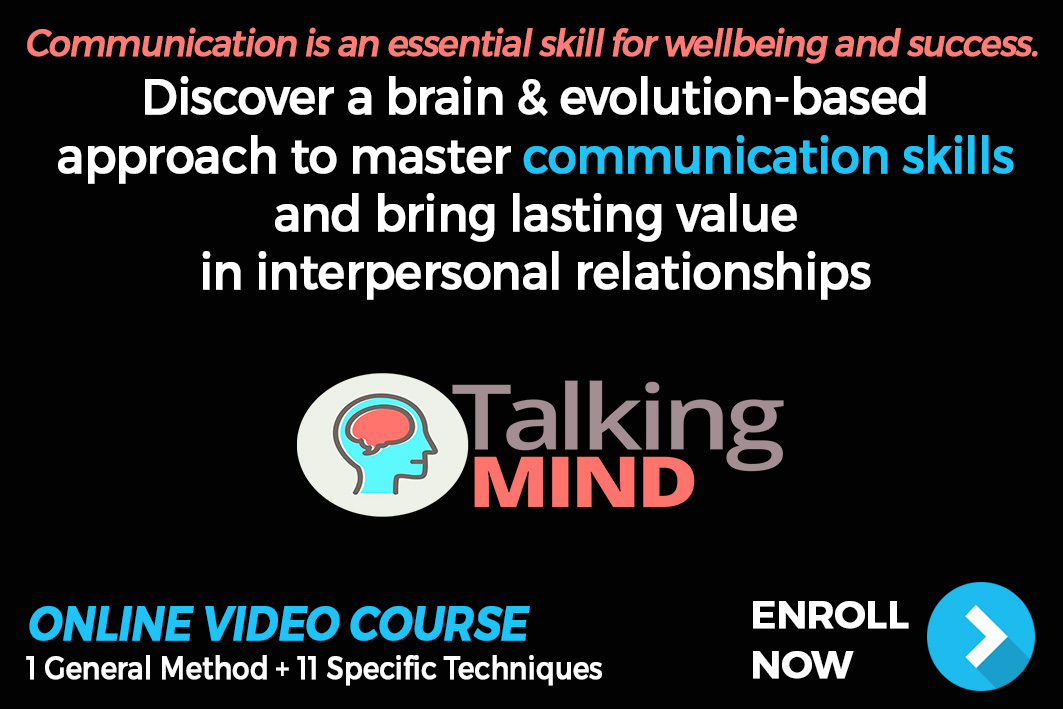
15 Mar The Roarless Lion – Why People Cannot Say What They Want
Authors: Fabio Sinibaldi and Sara Achilli
Language, Thinking and Power Are Mutually Influencing in Relationships
“How many times do I have to tell you?!”
I think this is one of the most frustrating things one could say – not that having it said is much better. This happens because this sentence implies the total failure of verbal communication: in order to see something come true, saying it is not enough. Especially if someone else must do it.
We often witness a paradox – the more we insist on something, the more we become pressing and annoying. But the other person’s annoyance is not going to be a temporary one. With time it leaves a very bad sign, developing the (more or less conscious) feeling that the interlocutor used to insist because they aren’t sure about themselves and have little faith in the other one. This is exactly the opposite of what motivates a person to do something. In the end, the tool we chose for a result actually ends up causing its exact opposite.
Moreover, this verbal communication often comes with incoherence on a nonverbal level. I am not talking about gestures and what we classically mean by paraverbal. Instead, what I am talking about is a nonverbal level of deep consciousness.
Let me explain with a concrete example
Think about a boss at work, a mother or a father raising their voices to impose their will on an employee or child. Try to clearly imagine the tone of voice and the relative muscular tension. What are they conveying? Most of the time it’s tension, fear of losing control, desire to impose, sometimes fear of judgment from witnessing people or, as an opposite, the hope of being appreciated. As you surely know from your own personal experience, the receiver clearly perceives all of this. As a consequence, they obey only because of fear or because there is nothing else to do, not because of a sign of great esteem, which in fact is likely to be lost.
 Try to think of a lion roaring. What does it convey? Maximum self-confidence, power and control. A lion roars because it is aware of its resources. It doesn’t do it because it is scared, wants to mark important boundaries or to be admired. Animals submitting to the lion’s roar do it as a sign of respect, unless they want to start a peer-to-peer challenge.
Try to think of a lion roaring. What does it convey? Maximum self-confidence, power and control. A lion roars because it is aware of its resources. It doesn’t do it because it is scared, wants to mark important boundaries or to be admired. Animals submitting to the lion’s roar do it as a sign of respect, unless they want to start a peer-to-peer challenge.
On an evolutionary point of view, verbal communication developed to further improve the potentials of non-verbal communication. But, as we saw in the previous example, it doesn’t necessarily work well all the time.
Human beings have developed a strong bond between communication and thinking. We can actually say we think like we speak or, vice-versa, we speak like we think.
What we want to outline here is not this question, like the egg and the hen, but rather seeing that these two functions are almost fused together in human beings. If, for instance, you go and live abroad, after a while you start thinking in the local language. On the other hand, if you struggle to think in a language that is not your native one, you will increase your communicative skills in that language.
Thinking, though, may have other forms and characteristics which are not linked to language. Language, for instance, is a serial structure, while visual and imaginary thinking allows for broader and more systemic vision. But there’s more: with the first example we saw that human beings believe logical thinking can solve almost anything and, since logical thinking seems to coincide with verbal language, we think we can achieve whatever we want with words. But it is not like that, at least on a deep level. Trust can be “deceived by language.” But this is not going to last in the long term, if not based on other deeper aspects relating to our old mammal instincts, which we fortunately still have (even if we often set them aside).
It is not about leaving verbal communication aside, since it can be very useful. Rather, we are talking about bringing it to its “original level” so to speak, support thinking and to constructively exchange with one another.
To do that, it is useful to bring it back to a concept of communicative physiology and its interactions with thinking, emotions and relationships.
 That’s why we created the term Talking Mind: the mind that talks.
That’s why we created the term Talking Mind: the mind that talks.
When studying the differences between constructive and dysfunctional types of communication we always verified criteria such as spontaneity, absence of filters (if not functional ones), a tendency to share and not to hide, an augmentative perspective of the incoming information and comparison of it, total lack of manipulation and an ulterior aim.
People communicating this way reinforce their openness of mind, thinking skills and awareness in their resources, as well as confidence to actively act upon the surrounding world.
The topic was particularly interesting, considering the different levels of action and its many application fields.
We then wondered what behaviors triggered the Talking Mind and how they could be favored.
Relevant Aspects Emerged:
- Speaking our mind, saying what we want, overcoming the fear our idea is worthless, that others may disapprove or not like it, that we could start a conflict etc.;
- Unveiling the unsaid parts of the communication, which only cause tension, frustration, resentment or other non-constructive and annoying situations;
- Leading people to be responsible for what they say in a light manner;
- Using some “bridges”, something to prepare our mind and/or emotions to receive information in its correct perspective and without prejudices or being worried about it;
- Stepping out of pre-established roles people use to pigeonhole their interlocutors (“they know the truth, the others must learn it”, “They speak, nobody must interrupt them”, etc.).
In the last two years we worked on these topics, developing a general method and 11 specific techniques to develop communication strategies of a Talking Mind and, consequently, support and reinforce thinking and relationships.





